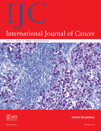A nation-wide study comparing sporadic and familial adenomatous polyposis-related desmoid-type fibromatoses
Abstract
Desmoid-type fibromatoses are neoplasms of fibroblastic origin, occurring sporadically or associated with familial adenomatous polyposis (FAP) coli. By comparing sporadic and FAP-associated desmoid-type fibromatoses, we tried to identify clinical characteristics, which may indicate FAP. Histopathology data of all Dutch patients with desmoid-type fibromatoses diagnosed between 1999 and 2009 were retrieved from PALGA, the nation-wide network and registry of histopathology in the Netherlands. For calculation of incidence rates, person-years from the general matched population were used. Based on polyp counts in pathological records, the cohort was divided into a FAP group and a non-FAP group. Patient- and tumor characteristics were compared between the two groups. A total number of 519 patients older than 10 years with a confirmed diagnosis of desmoid-type fibromatoses were included. Thirty-nine (7.5%) desmoid patients were documented of having FAP. The incidences of sporadic and FAP-related desmoid-type fibromatoses were 3.42 and 2,784 per million person-years, respectively. The majority of FAP patients developed desmoid-type fibromatoses after the diagnosis of FAP. Having FAP was associated with male gender [odds ratio (OR) 2.0, p = 0.034], desmoid diagnosis at an earlier age (mean 36 vs. 42 years, p = 0.031), and desmoid localization intra-abdominally (OR 18.9, p ≤ 0.001) or in the abdominal wall (OR 4.8, p ≤ 0.001), compared to extra-abdominal desmoid localization. In conclusion, patients with desmoid-type fibromatoses are at risk of underlying FAP. Especially cases with desmoid localization intra-abdominal or in the abdominal wall, and all patients younger than 60 years, have a substantial increased risk and should be referred for colonoscopy.




